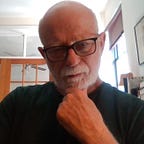The Eve of Nothing
Lennon and Seinfeld for 2023
Can you imagine New Year’s Eve without “Imagine?” Once again this December 31st, at five minutes to midnight, a hush will fall over Times Square and a solo voice — this time, indie pop star Chelsea Cutler — — will intone John Lennon’s limpid lyric:
Imagine there’s no Heaven –
It’s easy if you try.
No Hell below us,
Above us only sky…
This dreamy meditation has been the prelude since 2005 to the midnight Ball Drop, a kind of invocation of Nothing before a big Something hits your eye. It works. Thousands of young people in the square, and millions more watching on TV or online will sing along with an anthem that negates everything their ancestors lived and died for — religion and country, progress and possessions — and replaces them with, well, nothing.
And what would that look like? Well, imagine a show about Nothing…
Heavily influenced by his wife Yoko Ono, Lennon wrote “Imagine” in 1971, near the bitter end of the Vietnam War and the couple’s long campaign for peace. Sweetened with a lush string background, it became his biggest hit single, and an iconic statement after his murder in 1980. Seemingly a refusal to accept the world that produced his senseless, violent death, it’s been a theme song for every generation since the Baby Boom, sung reverently and defiantly at high-school and even Sunday-school graduations.
“Imagine no possessions,
I wonder if you can …
Lennon described the song as a “sugar-coated” version of The Communist Manifesto. However a check of the actual Manifesto finds not so much a “brotherhood of man,” but a recipe for retribution. It’s about the overthrow of one class by another.
“Imagine” simply envisions an end to all serious conflict, a community of friends with no possessions, sharing all the world and “living for today.” The song had its critics in the Seventies, most of whom pointed to John and Yoko’s luxurious lifestyle and wondered how they’d do with nothing to their names. In the “Imagine” video, the sign over the door to the couple’s mansion says “this is not here,” a typical Ono-esque abnegation. But what kind of society could exist on such immaterial ground?
Something like it appeared in 1991, and captured the imagination of America. The characters in “Seinfeld” are a brother- and sisterhood of friends who own nothing of value, believe in nothing, belong to nothing and no one, and will stop at nothing in their pursuit of nothing. Jerry’s apartment is their common ground, and Jerry’s purse is open, with only minor grumbling on his part, to cover the costs of his and everyone else’s misadventures.
Look up! George, Elaine, Jerry, Cosmo — the world is singing to you.
Don’t get me wrong. I am an original Beatle fan, an admirer and mourner of a martyred New Yorker in John Lennon; a long-time Upper West Sider who eats at that very Restaurant on 112th, and goes to bed giggling at “Seinfeld” reruns.
I just wonder. Could a “festivus for the rest of us” really replace Christmas, Chanukah, etc? Could peace be built on petty squabbling, prosperity on mooching? Could we nourish ourselves on cereal and Big Salads? If we ignore yesterday and tomorrow, can we still live fully for today?
Or as we contemplate this TV incarnation of Lennon’s sugar-coated nihilism, are we gazing at a kind of comic suicide pact, described by Bill Wyman in a 2002 Salon essay: “The show is all about the joy of charting, in exquisite, unrelenting, almost celebratory detail, the infinitely variegated human interactions that, closely watched, will ultimately tell the story of the disintegration of our species.”
In any case — Happy 2023!
Copyright 2022 by Tom Phillips
